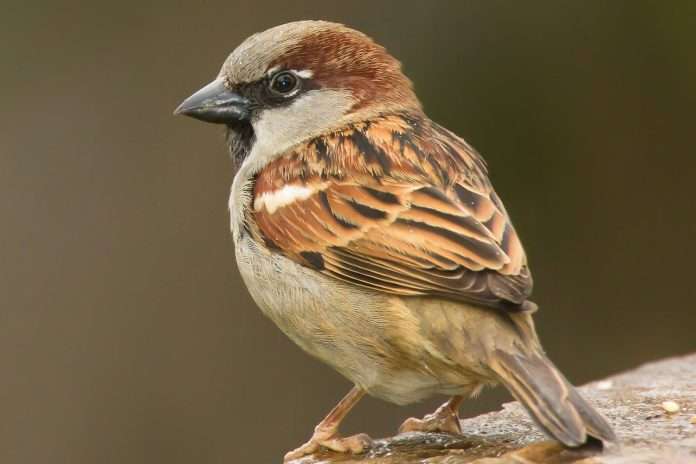The House sparrow is a small bird of the sparrow family passeride found in most parts of the world. Its usual length is 16 cm. Females and young are of brown and grey colour. Males are brighter black, white and brown markings. Sparrows are found mostly in Europe Mediterranean Basin and large parts of Asia.
The sparrow is a house hold bird. It likes to live in human habitation. The diet of sparrow are seeds of grains, flowering plants and weeds. Also sparrow is opportunistic and catches insects, their larvae, caterpillars, invertebrates and many other natural foods. Now-a-days sparrows are declining in numbers.
The bird’s scientific name and the English name have the same meaning. Passer and sparrow mean small active birds and are speedy and agile. The sparrows are well known for their agility and chirping. Domesticus means belonging to the house. Passer Domesticus is the Scientific name of sparrow.
The hose sparrow originated in the middle east and spread most of Eurasia and parts of North Africa. Since the mid 19th century it has reached most of the world. The adaptability of sparrow is quite remarkable . It is close to humans. It tolerates various climates, but prefers drier conditions. It has ability to survive without water by ingesting berries. The house sparrow is very common despite some …declining……….lines.
The house sparrow is a very social bird. In all sense…, it is gregarious. They bath in water and dust. The house sparrows sleep in the trees communally. Communal chirping they make before and after sleep. The house sparrows flight is direct. On the ground it typically hops rather than walks. Most house sparrows do not move more than a few kilometres during their life times.
House sparrows can breed in the breeding season immediately following their hatching. Birds breeding for the first time are rarely Successful in raising young. Success increases with age. As the breeeeding seaon approaches hormone increases the size of the sexual organs. The males starts calling by nesting sites.
The house sparrow is monogamous and males for life. Males guard their mates carefully to avoid being cuckolded. Males have sometimes have multiple mates and bigamy is mostly limited by aggression between females. Lost mates of both sexes can be replaced quickly during the breeding season. The formation of a pair and the bond between the two birds is tied to the holding of a nest site. But house sparrows can recognise each other away from the nest. Nest sites are varied, though cavities are preferred. In rural areas sparrows make nests under the thatched roofs. A sparrow sometimes excavates its own nests in sandy banks or rotten branches.
Sparrows are referred to in many ancient works of literature and religious texts of in Europe and western Asia. The sparrows are known as seed eating birds. In Greece sparrow is associated with Goddess Aphrodite, the goddess of love because of luststfulness of sparrows. This has been marked by chaucer and Shakespeare also. Jesus used sparrow as an example of divine providence in the Gospal of Mathew.
World sparrow day on 20 March every year is observed to promote awareness about the conservation and protection of sparrows, whose numbers are falling globally.
(The views expressed are the writer’s own.)

Radhakanta Seth is an Income tax officer in Sambalpur. He is a Freelance writer and his articles have been published in some Oriya dailies like Sambad, Samaj, Dharitri and English dailies like The Telegraph and in a sociological journal ‘Folklore’ published from Kolkata.

